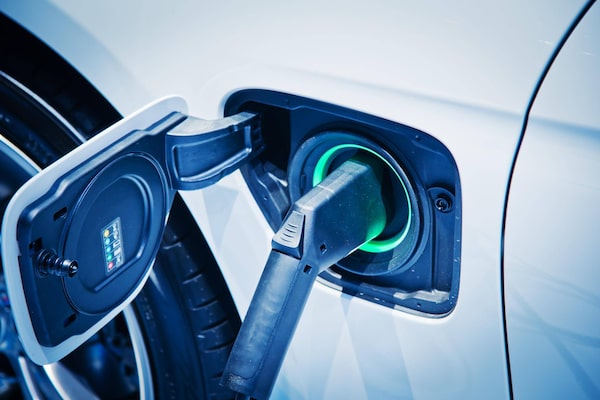
Patiwit/Getty Images/iStockphoto
Back in the spring, somebody bought the 100,000th electric car to hit Canadian roads. It was probably someone in Quebec, where electric vehicles (EVs) are most popular, and where more than 3,800 were sold in the first three months of 2019.
That’s a big round number, eight years in the making since the arrival of the first Nissan Leaf, but EV advocates believe it will double within three years. And who knows how the electric snowball will keep growing after that?
So suck it up, all you EV haters and armchair critics. Electric vehicles are here. They’re not a fad. They’re not going away. Even if you’re in Saskatchewan with a pickup truck in the driveway, if you live for another decade, there’ll almost certainly be an EV in your future.
Right now, the Electric Mobility Canada organization estimates about 1.9 per cent of passenger vehicles sold each year are powered either solely by a battery that’s charged from a plug (Battery Electric Vehicles, or BEVs) or by a plug-in battery that’s helped along with a gas engine (Plug-in Hybrid Electric Vehicles, or PHEVs).
Keep the green in your wallet with these seven budget-friendly electric vehicles
Here’s all you need to know about charging your EVs
What keeps car buyers from switching to electric vehicles?
Sure, there’s still a long way to go. EV sales are only a very small percentage of Canada’s roughly 23 million road-going light vehicles. Critics are quick to dismiss this fraction as irrelevant, but it’s not.
The fact is, automakers aren’t building EVs because they think the public wants them; if the public turns them down, they won’t scrap them like a Pontiac Aztek or Ford Edsel. They’d like to, but they can’t. They’re building EVs because they have to meet government emissions targets that are averaged among all the vehicles in their fleets: For all the gas-slurping Chevy Corvettes that General Motors sells, it needs to equal out the overall consumption by selling power-sipping Chevy Bolts.
Even more crucial, many well-intentioned governments around the world are demanding that automakers sell electric cars, and fining them when they don’t sell enough. Quebec is the only Canadian province currently doing this, but it’s following the lead of California, as well as some European countries such as Britain and France. They are actively working to phase out the sale of internal-combustion-powered vehicles by 2040, or earlier. Ireland just announced an optimistic 2030 date, but Norway wants to be there by 2025.
Those governments impose fines on automakers that don’t sell a high enough proportion of EVs compared with conventionally-powered cars, and the proportion increases each year. It hurts, too. Mazda does not currently have an EV to sell, and in 2018, it estimates it paid $5-million to the Quebec government in penalties. It will be more this year.
This movement is unstoppable by any one country. Not even the dramatic rollbacks of emissions demands by the Trump administration in the United States can change the trend.
Sure, Ontario’s cancellation of its EV incentive program and B.C.’s recent halving of its similar program will affect local demand. But in the long run, they’re no more than blips. They’re counteracted by the new federal incentive program, and in any case, demand will be led more by broader economic conditions and international oil prices.
“You’re talking about massive fleets of cars around the world converting to becoming fully electric, or at least electric-hybrid, over all the drivers in the world,” says Elliot Johnson, chief investment officer for investing firm Evolve ETF, which offers an automobile innovation index fund called CARS. “I don’t think these incentives really make a whole lot of difference to the overall theme. This is not going to go away anytime soon.”
There are roughly two dozen different EVs on sale in Canada today, but globally, the McKinsey & Company research firm estimates automakers will launch as many as 340 new EVs in the next three years. Already, last year, more than a million EVs were sold around the world, with roughly two out of three being BEVs. Most of those were in China, which has a larger EV market than the United States and Europe combined, but the run-off is inevitable. McKinsey believes EV sales could quadruple to constitute up to 5 per cent of the world market for passenger vehicles as soon as the end of next year.
In the longer term, the potential numbers are far higher. Bloomberg estimates EVs could be 25 per cent of global market share by 2040.
What’s the tipping point? A BMW executive once said it will be when your neighbour buys an electric vehicle – when you realize that when it’s time to sell your next car, it had better be electric if people will want to buy it.
So take a good look at that vehicle in your driveway – even if you’re in Saskatchewan. Chances are, in 10 years’ time, its battery will be plugged in and charging.
There are some interesting electric concept cars on display at the New York International Auto Show this year. Matt Bubbers and Petrina Gentile discuss the popularity of EVs among automakers versus buyer uptake.
Stay on top of all our Drive stories. We have a Drive newsletter covering car reviews, innovative new cars and the ups and downs of everyday driving. Sign up today.